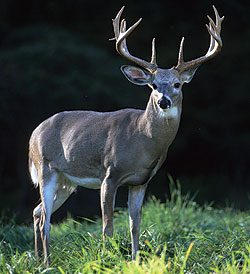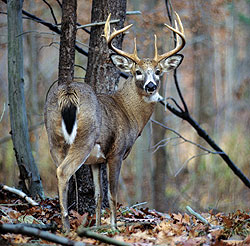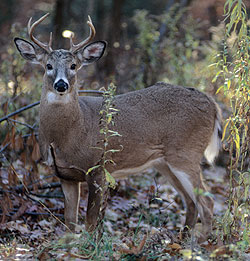October 28, 2010
By Bob Humphrey
 This is the same buck pictured at 1€‰1„2, 2€‰1„2 and 3€‰1„2 years old. Careful study of not just antler size but body characteristics will help you become proficient at identifying mature bucks that show up at your stand. Photos by Charles Alshemer |
The afternoon was winding down quickly; too quickly, as far as I was concerned. Sitting in a ground blind alongside a lush food plot in southeast Ohio, I'd seen several does and a couple small bucks, but nothing to really get my attention. The sun had already dipped well below the trees, and I was counting down the minutes when I saw a big-bodied deer enter the field to the west of me.
He seemed to have a good rack, but looking straight into what remained of evening light made any sort of accurate field judging next to impossible. We'd been given clear instructions on what to shoot: mature buck, eight points or better, outside the ears. I was pretty sure about the spread, and the bases seemed thick, but the tines were almost invisible against a backlit maze of tree limbs. I just couldn't tell. Adding to my anxiety, he was headed my way on a steady walk, and I had only seconds to decide. Forget the rack, I told myself. Look at the body. With a quick look, I could clearly see he had all the physical characteristics of a mature buck. Draw, aim, shoot. I was as sure it was a mature buck as I was that I'd shot over his back. The neighbor confirmed it a couple weeks later -- after he shot and recovered the 10-pointer and found a healed scar across its withers.
Advertisement
In choosing to pick up stick and string rather than a firestick, bowhunters make a personal decision to place restrictions on themselves. Increasingly, and for various reasons, both bow and gun hunters are doing the same thing by electing to shoot only mature bucks. It's one of the tenets of quality management and represents an additional challenge to the hunter. Sometimes, however, the biggest challenge may not be putting yourself in a position to take a mature buck, but being able to recognize one when you see it. Recent research suggests it may not be as easy as you think.
 Photos by Charles Alshemer |
What's A Mature Buck?
Before we go about deciding how to distinguish one, we first need to define what a mature buck is. I recently read an entire article on the subject in which the author offered all sorts of determining factors such as local age structure, behavior and even hunting pressure, but he skirted around the simple truth. Mature means done growing. The skeletal structure of a whitetail deer continues to grow through the first three years of life. Somewhere around the time it reaches four, it's done growing. It is mature. From that point on, surplus nutrition and minerals go toward body mass and antlers.
Advertisement
 Photos by Charles Alshemer |
How Do You Know?
The most reliable indicator of a mature buck is physical appearance. For years, we've been taught that the neck region of a mature buck is fully muscled and appears to blend into the shoulders. The shoulders are as thick as the rear, and the waistline has dropped down to become even with and as deep as the chest. This broadening of the trunk makes legs appear too short for the body. There are other clues, such as antler bases at least as big as the deer's eyes and dark tarsal staining during the rut, which may extend below the tarsal gland. Lots of folks have been doing it that way, but until recently, no one has done a scientific evaluation of this aging method.
Last year, Ken Gee of the Samuel Roberts Noble Foundation did just that. He prepared an intensive online survey for volunteer participants selected from the registrants of the 2009 Southeast Deer Study Group. The group of 129 participants included 107 wildlife professionals who use the technique in their work. Gee found an indirect correlation between deer age and correct age-class estimation. In other words, the older the deer, the less accurate people were in correctly estimating age. Only 30 percent of the 4½-year-old bucks were correctly aged.
Keep in mind that study used a sample of participants and deer from a broad geographic area. I hunt all around the country every year, and while I feel fairly confident at being able to recognize a mature buck anywhere north of the Mason-Dixon line, I sometimes struggle in the Southeast and Texas, where a mature buck weighs about the same as a 2-year-old or even a very healthy yearling back home.
Gee's study also compared accuracy in judging for every age class from 1 1/2-10 1/2. It's reasonable to assume the level of accuracy would be much higher if they asked participants to simply determine if the buck was mature or not. And if they were looking at pictures of deer from the geographic area where they work and/or hunt, it might be higher still.
In other words, the body characteristics we've been using all along are still a reasonably good method for making a best guess on the hoof. And if you're wrong, so what? If the deer was big enough for you to shoot at it, you'll probably be satisfied with the results regardless of what it says on his birth certificate.
